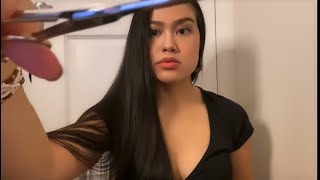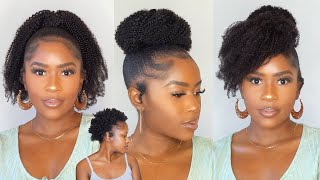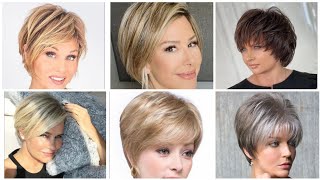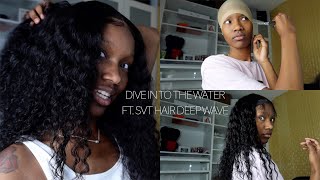How To Cut A Blunt Bob Haircut | Step By Step
- Posted on 21 January, 2021
- Bob Hairstyles
- By Anonymous
TEXT ME! 215-608-2612
Create a FREE Profile and Watch Hundreds of Hair Education Videos Here!
https://bit.ly/FreeSalonEducation
Shop the FSE Store Here!
Get the FSE NOW App!
iPhone: https://bit.ly/FSENOW
Android: https://bit.ly/FSENOWGoogle
Follow me on Instagram: https://bit.ly/FSEINSTAGRAM
Follow me on Twitter: https://bit.ly/FSETWITTER
My goal for creating something simple and classic like a line technique is to approach it with precision. This starts with prep combing, all hair into natural fall, keeping the hair nice and wet for control, clean, sectioning and consistent combing are all mechanics that keep me organized and precise. The challenge in each line technique is the details of each individual guest from inconsistent density at nape and hairline to neck shoulders and ears being able to maneuver around these obstacles is key in achieving the desired precise outcome using horizontal sections. My cutting line will control my length from back to front and my elevation is controlling my technique. You could see that i'm using my comb as a ruler while i set a foundation for my shape with zero elevation to control my technique, and my cutting line is horizontal controlling my length from back to front together. My guest and i decided on this length based on density, wave pattern and where this would sit in relation to her jawline notice. Each section is being taken clean, but i'm clipping the hair away with less tension. This is allowing for my guest scalp to sit natural to the shape that i'm cutting too much tension on a section in your hands or the section being clipped away with too much tension will alter the end result of your shape. Finding the correct amount of tension for each guest and being consistent with that tension is extremely important as i work through this line technique, i'm using the wide teeth of the comb, putting little to no tension on each section to allow for some feedback from her natural Wave pattern: my comb is only there to help guide me horizontally and also to control the hair and keep it as close to the skin as possible. When i cut my client's head position, body position and the ability of my guests to sit still are also necessary for me, as an artist to achieve the best possible end result for me and my guest. These are things that i like to talk about. In the consultation so that we are both set up for success during the hair cutting process, these positions might change during the haircutting process. So it's important that i keep an open dialogue of communication, reminding my guests, what position they should be in while continuing to thank them for helping me to create the best shape possible to them. Understand that my main goal is to cut this shape about. Eighty percent. Perfect wet and then blow dry, smooth and refine the remaining twenty percent to precision. This will give me the most versatile and most durable longevity out of each and every haircut after my wet shape is finished. I can be confident their hair will hold up when they style their hair, natural and wavy once refined, smooth and dry. I will also rest assured this shape is precise enough for them to wear it, smooth, as well as a young hair stylist. I would often try and be too perfect with my wet shape. I'D then blow dry and wish. I had back some of what i had cut off wet as i've gained experience. I'Ve noticed by working with less tension on a perimeter shape like this. I have to trust my process and not micromanage, wet hair section by section. I continue to remind myself that my guests are not paying for a perfect wet haircut. They are paying for the best looking and dry result. This does not mean we should rush through the wet portion, but just be mindful that this is a rough draft. The refining process is the final polish that will complete the look as i move up. The head shape you'll notice. The hair is not segmented into four quadrants. I'Ve learned from trial and error that the best approach to a seamless and clean line is to approach it as fluid as possible. I found the segmenting from front to back only creates more opportunity for me to shift my cutting line or my elevation unintentionally, similar to drawing one straight line with the help of a ruler working a continuous line from back to front hairline cuts down on the human Error and you'll see in the end result that there is no separation from front to back. My line is infinite and uninterrupted in the cutting process, and this allows for that. Seamless transition and predictable end result. Ears are what i consider to be another obstacle to creating a solid perimeter shape, but they don't need to be complicated. We just need to be sure that the hair, above the ear is long enough that it can travel over or around the ear to reach our desired length, simply tap above the ear or leave that section entirely uncut until refinement that will easily solve this issue. Using little to no tension in the front is allowing for me to make sure i'm keeping length in an area that is less dense than other parts of the head shape. You'Ll also notice. I have combed the hairline to the temple. This helps me to make sure i'm not unintentionally over directing the front and cutting off the corner that i purposely created by using the approach i used today on a one length, you will be able to minimize the things that are out of your control and maximize The focus on the details and discipline required to duplicate a precision line technique on any guest with any hair type. So you guys can see the beautiful end result from ryan's haircut. It'S all smoothed out now we're going to go in add a little bit of life to it. Uh using the paul mitchell, neuro, titanium flat iron, just give it a little twist and bend, and you can see all the movement that pops into that one length haircut. So we'll just finish it off with a little paul mitchell, neuro protect and you guys got your end result. Hope you enjoyed the video. Let us know if you have any questions in the comments. Thank you so much for watching





Comments
Sweet Violets: Love this video... Thank you so much.... For a newbie hair stylist, this technique means a lot.... Keep safe and healthy! ...God bless!❤️
Haley Sperbeck: Fades and Blunt bobs are my favorite Cuts to do! Awesome video,It took me awhile to learn how to do a great blunt bob,but once you do,it's amazing
Eli Peart: Excellent video. Thanks so much for this tutorial.
K: Stylist should have the model tilt her head down when the she is doing the back of the cut. Doing so, will help eliminate the very bottom length from being longer than the length above it. If you start with the head at the normal position, and cut it without tilting it down, you’ll see the longer length peak out when the model eventually tilts her head down and then will have to go back and fix it.
Bianca Fahlin: Love it! Though Ryan's nails were a TOTAL show stopper! I'm so jealous.
Yarelis Alcántara: No , habló tu idioma pero te entiendo perfectamente.excelente trabajo te felicito
Nesia_b: Great video. Great advice
Brucehaopuhaokip Lanchahpa: Hello sir please make more videos for long layer hair cutting. Thank you
Hasnaa channel: Great job bravo
Kimber Ly: I have a question. What do you do for someone who only wears a side part? I don't really care for the center part, as I don't have the right shape of face/head. Is this something that can be done?
Muriel Gibson: Please can you show us uniform hair Cuts
saks5: The final color was not the same during the hair cut, they made a highlight
Carol Marsden: Any comments,, !! Yes ,,, Please do my hair,,, x Love this
miss hicks: And here I am putting a rubber band on my hair and and cutting it lol
HeadHome: Wow lovely
Muriel Gibson: Sir thanks
carlos pachon: Inclinado
joan angel: Who's this person? Cant cope. They nails drowning out what he's saying and doing. Where's Matt?
Inessa Iv: Are you seriously? it's boring but for basis is good .